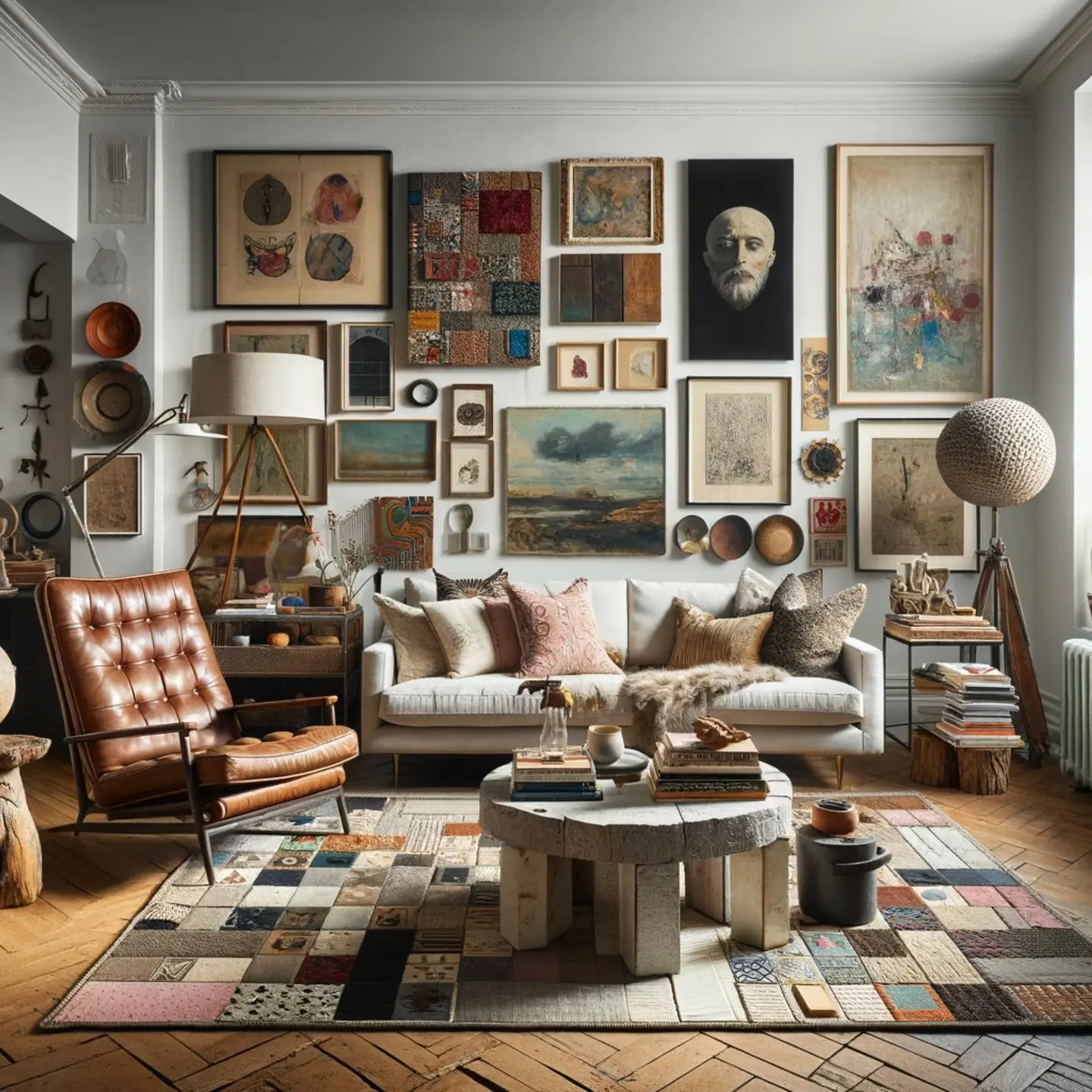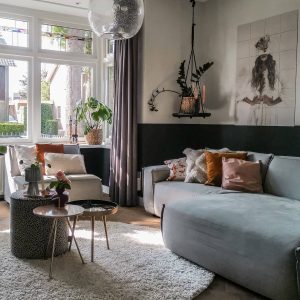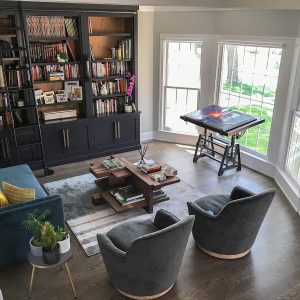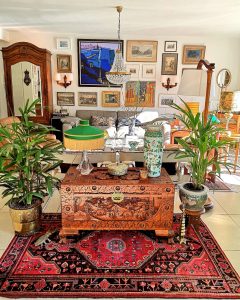‘How To Mix Patterns And Textures In Eclectic Decor‘ is an exciting journey into the art of creating dynamic, personalized living spaces.
At its heart, eclectic decor is about embracing the richness of diversity in your living spaces, blending various patterns, textures, and styles to reflect a story uniquely yours.
Yet, the challenge often lies in mixing these elements harmoniously without tipping the scale towards visual chaos.
How do you navigate this delicate balance?
Through this guide, we’ll explore how to harmonize these elements, ensuring our homes reflect a balanced, vibrant, and deeply personal aesthetic.
Let’s unlock the secrets to mastering the eclectic mix, transforming any space into a reflection of your individuality and creative vision.
How To Mix Patterns And Textures In Eclectic Decor
What Is Eclectic Decor? Understanding Its Core Elements
Eclectic decor is the art of harmonizing seemingly disparate styles, time periods, textures, and colors into a cohesive whole. It rejects the notion of sticking to one design rulebook, instead celebrating the freedom of mixing and matching to achieve a space that is reflective of your personal tastes and experiences. This design approach is characterized by its versatility, allowing for a playful yet thoughtful assembly of elements that can evolve with your style over time.
Characteristics of Eclectic Decor
Eclectic decor stands out for several key features:
- Diversity in Styles: It blends elements from multiple decor styles—be it mid-century modern, bohemian, or industrial, to name a few.
- Variety in Textures and Patterns: A rich mix of textures and patterns adds depth and interest, preventing the space from feeling flat or monotonous.
- Bold Use of Color: While eclectic decor can certainly include neutral palettes, it often features bold and unexpected color combinations.
- Personal Touch: Perhaps the most distinguishing characteristic is its emphasis on personalization, allowing for unique collections, art, and decor items to take center stage.
Why Eclectic Decor Is Popular
Eclectic decor’s popularity lies in its inclusivity and flexibility. It invites homeowners and designers to break free from traditional decor constraints, offering a canvas on which personal narratives and stylistic preferences can play out.
This approach to decorating is particularly appealing because it:
- Fosters Creativity: It encourages creative expression through the thoughtful layering and juxtaposition of various decor elements.
- Is Adaptable: Eclectic decor can easily accommodate new pieces or adapt to changing tastes, making it a sustainable choice for those who love to evolve their interiors.
- Celebrates Individuality: More than any other style, eclectic decor values the uniqueness of the individual, turning homes into deeply personal spaces that tell a story.
Mixing Patterns 101: Essential Tips for Eclectic Decorating
Diving into the eclectic decor, the ability to mix patterns effectively is foundational. It’s about more than just throwing together your favorite prints; it’s a delicate dance of balance, scale, and harmony.
Here are the essential guidelines to get you started on the right foot.
The Rule of Three
A good starting point is the Rule of Three. This rule suggests using three different patterns in varying scales to create depth and interest without overwhelming the space. Here’s how to apply it:
- Choose a Dominant Pattern: Start with a large-scale pattern that will serve as the focal point. This could be a bold rug or a statement piece of furniture.
- Select a Secondary Pattern: Choose a pattern that is different but complements the dominant one, ensuring it is of a medium scale to maintain visual balance.
- Incorporate a Tertiary Pattern: Finally, introduce a small-scale pattern that ties the other two together. This could be in the form of throw pillows, a throw blanket, or accessories.
Scale and Size
The interplay of scale and size is crucial in mixing patterns without creating visual clutter. The idea is to ensure that no single pattern overpowers the others but instead, they complement and elevate the overall design.
Keep these points in mind:
- Vary Scale Thoughtfully: Combining a mix of large, medium, and small patterns prevents any one pattern from dominating. Ensure there’s enough variation to keep the eye moving.
- Consider the Size of the Room: In smaller spaces, you might want to start with a smaller-scale dominant pattern to avoid overwhelming the area.
Choosing a Color Scheme
A cohesive color scheme can unify a diverse mix of patterns, creating a seamless look that feels intentional and harmonious.
Here’s how to approach it:
- Start with a Base Color: Identify a color that will serve as the foundation for your space, typically a neutral or a hue that you’re particularly drawn to.
- Build a Palette: Add complementary or analogous colors to your base color. These will guide your selection of patterns and ensure that despite their diversity, there’s an underlying cohesion.
- Use Color to Balance: If you’ve chosen a particularly bold pattern, balance it with more subdued patterns in complementary colors to avoid visual competition.
Adding Depth to Eclectic Spaces: A Guide to Textures
After mastering the art of mixing patterns, incorporating textures is the next step in elevating your eclectic decor. Textures add depth and interest, making a room feel layered and lived-in. They can soften the visual impact of bold patterns or add subtlety to a space with minimal pattern variation.
Here’s how to skillfully combine different textures in your eclectic decor.
Exploring Types of Textures
Textures in home decor can be broadly categorized into two types: visual and tactile. Visual textures refer to the appearance of a surface, while tactile textures are about how things feel to the touch. Incorporating a mix of both types enriches the sensory experience of a space.
Consider these texture types:
- Soft Textures: Think of plush rugs, velvet cushions, or chunky knit throws. Soft textures invite comfort and create a cozy, welcoming atmosphere.
- Hard Textures: Elements like wood, metal, and glass fall into this category. They provide contrast to soft textures and add structural definition to a room.
- Natural Textures: Incorporating natural elements like stone, bamboo, or plants can bring an earthy, grounding feel to your eclectic mix.
- Glossy and Matte Finishes: Playing with finishes can also add texture. Combining glossy and matte surfaces creates visual depth and interest.
How to Combine Different Textures
The key to combining textures lies in balance and contrast. Just like with patterns, you want to achieve a layered look that feels cohesive and intentional.
Here are some strategies:
- Start with a Base Texture: Just as you would with a base color, start with a primary texture that sets the tone for the room. This could be the smooth leather of a sofa or the rough texture of a brick wall.
- Add Contrasting Textures: Introduce textures that contrast with your base texture. If your base is smooth, add some rough or soft elements. This contrast is what creates interest.
- Layer Textures Thoughtfully: Consider how different textures will interact. Layering a soft, plush rug on a sleek hardwood floor, for example, adds warmth and comfort.
- Balance is Key: Ensure that no single texture overwhelms the space. Distribute textures evenly throughout the room to maintain harmony.
Texture and Light
Don’t forget the role of light in playing up textures. Natural and artificial light can highlight the depth of textures, making them more pronounced. Pay attention to how light interacts with the textures in your space throughout the day and use lighting fixtures to accentuate your favorite texture combinations at night.
Personal Touches
Personal items and collections can also add texture. Books, artwork, and decorative objects not only tell your story but add to the rich tapestry of textures in your home.
Top Strategies for Combining Patterns and Textures in Eclectic Interiors
Blending patterns and textures in eclectic decor allows for personal expression and creativity. However, achieving a balanced, harmonious look requires a thoughtful approach. Here are practical tips to guide you in mixing patterns and textures effectively, creating a space that feels cohesive, vibrant, and deeply personal.
Start with a Neutral Base
A neutral base provides a calm backdrop against which patterns and textures can stand out. This doesn’t mean your space needs to be devoid of color. Instead, use neutral tones for larger items or walls, which allows for more flexibility as you layer patterns and textures.
- Neutral Walls and Flooring: Consider soft whites, greys, or earth tones for your walls and main flooring. This creates a canvas for your eclectic decor.
- Large Furniture Items: Sofas, beds, and large furniture pieces in neutral colors can anchor the room, making it easier to introduce patterns and textures without overwhelming the space.
Layering Patterns and Textures
The art of layering is at the heart of eclectic decor. It involves adding various elements in a way that adds depth and interest without clutter.
- Incremental Approach: Start with larger areas and items, gradually adding smaller accessories and textiles. This lets you assess and adjust the balance as you go.
- Mix Patterns with Care: Use the rule of three for patterns, ensuring they vary in scale and relate through color or theme. This creates a cohesive look.
- Combine Textures for Contrast: Mix soft with hard, shiny with matte, and rough with smooth. This variety adds richness and complexity to your space.
Balance in the Mix
While eclectic decor embraces a mix of styles, maintaining balance is crucial to prevent a disjointed appearance.
- Symmetry and Asymmetry: Use both symmetrical and asymmetrical arrangements to create visual interest while maintaining balance.
- Focal Points: Every room should have one or two focal points, whether it’s a bold piece of art, a striking piece of furniture, or an accent wall. This draws the eye and anchors the room.
- Space and Breathing Room: Ensure each piece has its moment to shine by not overcrowding the space. Allow for areas of rest within the design where the eye can relax.
Experiment with Personal Items and Art
Your personal items, art, and collections are what truly make a space eclectic. These elements introduce unique patterns and textures while telling your story.
- Gallery Walls: A gallery wall can combine various frame textures and artwork styles, unified by a common color scheme or theme.
- Decorative Objects: Items collected from travels or heirlooms can add a personal touch and interesting textures.
- Books and Plants: Books add visual interest with their spines and covers, while plants introduce natural textures and vibrant color.
Test and Adjust
Creating the perfect eclectic mix doesn’t happen overnight. It’s a process of experimentation, testing different combinations, and adjusting as needed.
- Live with Your Choices: Before making permanent changes, live with your layout and decorative choices for a few days. This can help you better understand what works and what doesn’t.
- Edit and Curate: Don’t be afraid to remove items that disrupt the harmony of the space. Editing is as much a part of the process as adding new pieces.
Eclectic Decor by Room: Practical Examples and Ideas
Applying the principles of mixing patterns and textures in eclectic decor can transform any room into a vibrant and personalized space. Let’s explore how to apply these concepts across different rooms in your home, ensuring each space reflects your unique style while maintaining a cohesive look throughout.
Living Room
The living room is often the heart of the home, a space for relaxation and socializing.
Here’s how to mix patterns and textures effectively:
- Start with a Statement Rug: Choose a rug with a bold pattern as your anchor. This sets the tone for the rest of the room.
- Layer Textures on Seating: Combine soft, plush throws with textured pillows on your sofas and chairs. Opt for a variety of materials like velvet, wool, and linen.
- Incorporate a Mix of Lighting: Different lighting fixtures not only serve a functional purpose but can add to the room’s texture. Think of a sleek, metal floor lamp paired with a ceramic table lamp.
- Wall Art and Decor: Create a gallery wall with a mix of frame materials and artwork styles. This adds visual interest and personalizes the space.
Bedroom
The bedroom should be a serene retreat, a place where patterns and textures contribute to a calming atmosphere.
- Bedding as the Focal Point: Use your bedding to introduce patterns. Mix and match your duvet cover, sheets, and pillowcases in coordinating patterns.
- Textured Wall Treatments: Consider a textured wallpaper or a fabric headboard to add depth. These elements can serve as a backdrop for simpler bedding patterns.
- Soft Lighting: Use soft, warm lighting to highlight textures and create a cozy ambiance. Layered lighting from lamps, sconces, and candles can enhance the room’s textures at night.
Kitchen
The kitchen offers unique opportunities to mix patterns and textures, blending functionality with style.
- Backsplash as Art: Use your backsplash to introduce pattern into the kitchen. Tiles in interesting shapes or with bold designs can create a focal point.
- Mix Materials on Countertops and Cabinets: Combine different materials, such as wood cabinets with a stone countertop. This adds texture and visual interest to the space.
- Textiles and Accessories: Patterned kitchen towels, a textured rug near the sink, and decorative bowls or vases can add layers of interest to the kitchen without cluttering the workspace.
Balance and Cohesion Across Rooms
While each room can have its distinct flavor of eclectic decor, maintaining a sense of cohesion throughout your home is essential.
Achieve this by:
- Carrying Color Schemes: Let a consistent color palette flow from room to room. This doesn’t mean every room should look the same, but rather that there should be a harmonious blend of colors throughout.
- Repeating Textures: Echo textures in different areas. If you have a velvet accent chair in the living room, consider velvet throw pillows or a velvet ottoman in the bedroom.
- Unified Decor Elements: Incorporate a few decor elements that repeat in various rooms, such as a specific type of frame, lamp style, or decorative object. This subtly ties the spaces together.
Avoiding Common Pitfalls in Eclectic Design: Patterns and Textures
While the eclectic decor offers the freedom to experiment with patterns, textures, and styles, there are common pitfalls that can disrupt the harmony of your space. Being aware of these mistakes can help you navigate your decorating process more smoothly, ensuring that your eclectic mix feels intentional and balanced.
Overcrowding
One of the most frequent missteps in eclectic decor is overcrowding a room with too many items, patterns, or textures. This can lead to a space that feels chaotic rather than curated.
- Solution: Practice restraint and be selective about what you include in your space. Every piece should have a purpose or bring joy. Allow for negative space to give your decor room to breathe and enable individual pieces to stand out.
Neglecting Color Balance
Another common issue is the lack of a cohesive color scheme, which can make a room feel disjointed or overwhelming.
- Solution: Establish a color palette early in your decorating process and stick to it. This doesn’t mean you can’t use bold or contrasting colors, but they should complement the overall scheme and help unify the space.
Mismatching Scales and Proportions
Mixing patterns and textures without consideration for scale and proportion can result in a space where elements compete rather than complement each other.
- Solution: Pay attention to the scale of patterns and furniture in relation to the size of the room and other items. Use larger patterns in bigger spaces or on larger pieces, and reserve smaller patterns for accents or smaller areas.
Forgetting the Power of Editing
Falling in love with various items and wanting to include them all in your decor can lead to a cluttered space that lacks focus.
- Solution: Don’t be afraid to edit. Periodically assess your space and remove items that no longer fit or contribute to the overall aesthetic. Remember, eclectic decor is about the thoughtful accumulation of items, not about having everything on display at once.
Overlooking Lighting
Lighting plays a crucial role in how we perceive textures and colors in a room. Poor lighting can flatten the eclectic decor, diminishing the impact of carefully chosen textures and patterns.
- Solution: Incorporate a variety of light sources, including ambient, task, and accent lighting, to highlight textures and patterns effectively. Use dimmers to adjust the mood and focus of the room as needed.
Ignoring the Flow of the Space
An eclectic space should still have a logical flow and feel inviting. Ignoring the layout or making it too complex can make a room feel uninviting.
- Solution: Arrange furniture and decor to encourage easy movement and interaction within the space. Use rugs, lighting, and focal points to define different areas while maintaining a cohesive look.
Conclusion
Now you know ‘How To Mix Patterns And Textures In Eclectic Decor.’
The essence of eclectic decor lies in the thoughtful layering of patterns, textures, and styles—from the bold and vibrant to the subtle and understated. It’s a delicate balance that invites experimentation and evolution, allowing your space to grow and change with you over time.
Whether you’re mixing modern with vintage, bold patterns with muted textures, or incorporating cherished heirlooms alongside contemporary pieces, the goal is to create a cohesive blend that feels intentional and harmonious.
As you navigate the process, don’t shy away from trial and error.
Use the practical tips and guidelines provided as a starting point, but allow yourself the freedom to adjust and adapt based on what feels right for your space.
And most importantly, remember that the true beauty of eclectic decor is its ability to tell a story—your story—through the diverse and rich tapestry of elements that make up your home.
Happy decorating!
Frequently Asked Questions
1. Can Eclectic Decor Ever Be ‘Too Much’?
Absolutely. While eclectic decor celebrates diversity and personal expression, there’s a fine line between eclectic and chaotic. The key is balance—ensuring that despite the variety, the space feels cohesive and harmonious. If a room starts to feel overwhelming, it might be time to edit down and focus on what truly speaks to your style.
2. How Do I Know If My Patterns and Textures Are Working Together?
A good test is to take photographs of your space from different angles. Photos can help you see your room more objectively, highlighting areas where patterns or textures may clash or compete. Also, consider how the space makes you feel. It should reflect your personality and feel like a sanctuary, not a source of visual stress.
3. Can I Mix Modern and Vintage Styles in Eclectic Decor?
Mixing modern and vintage is not just acceptable in eclectic decor; it’s encouraged! The contrast between sleek, modern lines and the rich character of vintage pieces can create a dynamic and interesting space. The trick is to ensure that the items share a common thread, whether it’s color, texture, or an overarching theme that ties them together.
4. Is There a Rule for How Many Patterns I Can Mix?
While there’s no strict limit, the rule of three is a good starting point: one large, one medium, and one small pattern. However, what’s more important is how the patterns interact. They should share a common color or theme and be balanced throughout the space. If you’re unsure, add patterns gradually and live with each addition for a while to see how it feels.
5. How Do I Prevent My Eclectic Decor from Looking Dated?
The beauty of eclectic decor is its timelessness—by mixing elements from different eras and styles, you create a space that can’t be pinned to a specific trend. To keep it feeling fresh, regularly update smaller decor elements, maintain a balance of timeless and trendy pieces, and ensure your space evolves with your current tastes and lifestyle.
Related Posts:
- Eclectic Textiles for Every Room: How to Incorporate Them in Unique Ways
- What Is Eclectic Decor? An Ultimate Guide to Eclectic Style
- How To Create Balance In Eclectic Decor: Fundamental Principles
- How to Incorporate Vintage Eclectic Design in a Modern Space




